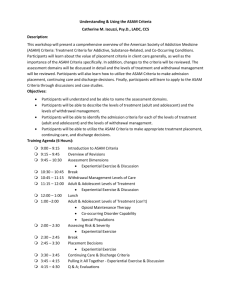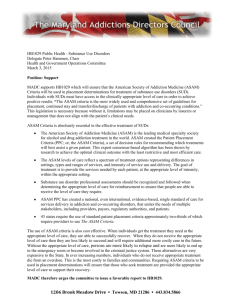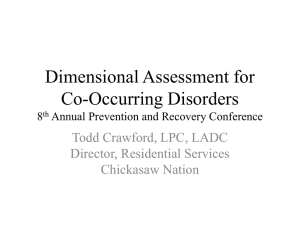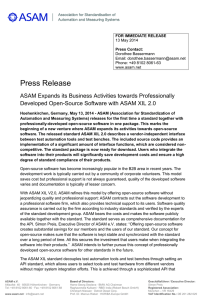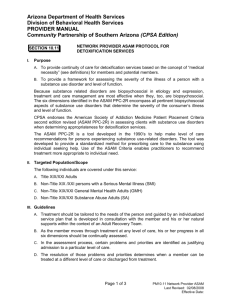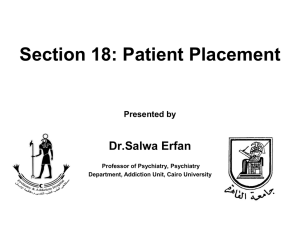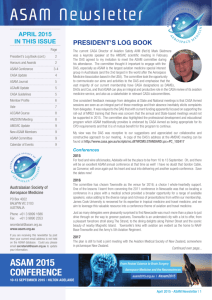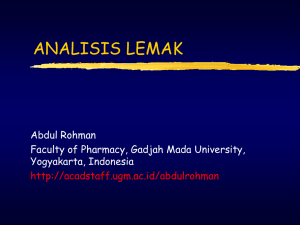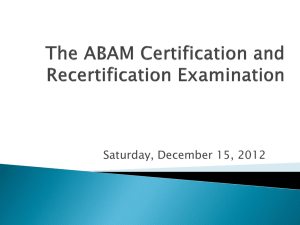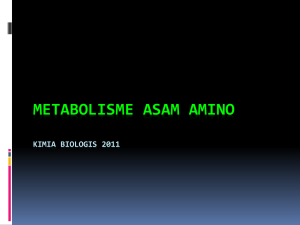ASAM Criteria Software
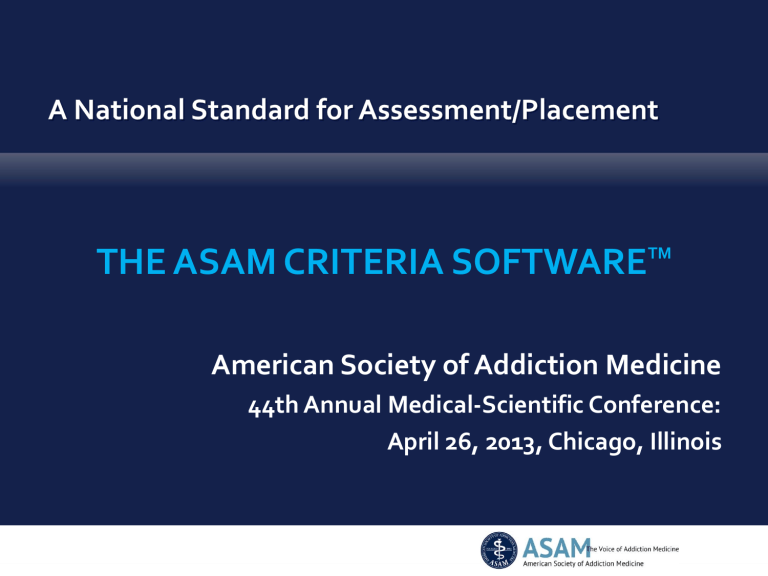
THE ASAM CRITERIA SOFTWARE
TM
American Society of Addiction Medicine
44th Annual Medical-Scientific Conference:
April 26, 2013, Chicago, Illinois
ASAM Disclosure of
Relevant Financial Relationships
Content of Activity:
ASAM Medical –Scientific Conference 2013
Name Commercial
Interests
Relevant
Financial
Relationships:
What Was
Received
Relevant
Financial
Relationships:
For What Role
No Relevant
Financial
Relationships with Any
Commercial
Interests
David Gastfriend Alkermes, Inc
Recovery
Search, Inc
Salary, Stock,
Options
Royalties
Rodney Conrad FEi Systems, Inc Salary
Company Officer
Company Officer
Company Officer
Paul Earley Earley
Consultancy LLC
Alkermes, Inc
Consulting Fees
Honoraria
Software
Consultant
Speaker
AGENDA
Rationale & background for a new standard of assessment & treatment planning
Dr Gastfriend - 15 min
Hands-on experience at the computer
Mr Conrad & Dr Earley - 45 min
Interactive discussion
Drs Gastfriend & Earley & Mr Conrad - 25 min
ASAM’s plans:
Dr Gastfriend - 10 min
Participants’ reaction:
All - 25 min
Rationale & background for a new standard of assessment and treatment planning
ASAM’s Goals
HBS’s Report Recommendations
SAMHSA’s Open Behavioral Health Information
Technology Architecture Project
Client
Researcher Counselor
Employer/
Payer
Society
Supervisor
Managed
Care
System
Accreditation Body,
Government
Corbel (Body)
• National Treatment Center Study - 450 programs
(U. of GA)
• >70% of respondents using ASAM Criteria by 1996
• For-profits: 54% less likely to adopt (p=.02)
• Single-level programs: 34% - 42% less likely than multi-levels (p<.01)
• Dual diagnosis capable programs:
3.4 times more likely to adopt (p ≤.01)
• Programs closing within 24 mos.
were less likely to be ASAM adopters in 1996 (p<.05)
• Programs closing within 6 mos. – even lower baseline adoption
HARVARD | BUSINESS | SCHOOL
Providers
Jerome Rhodes, President, Recovery Division, CRC Health Group
Nancy Paull MS, CEO, SSTAR of MA and RI
Ron Jackson MSW, Director, Evergreen Treatment Services, Seattle WA
Payers
Hyong Un MD, Chief Psychiatric Officer and Head of EAP, Aetna
Gary Henschen MD, Chief Medical Officer-Behavioral Health, Magellan
David Pating MD, Chief, Addiction Medicine, Kaiser Permanente SF Med Ctr
Tom Trabin PhD, Assoc Dir, Adult Care, Alameda County Behavioral Health, CA
Government/Non-Profit
Mady Chalk PhD, Dir, Center for Performance-Based Policy, TRI-U of PA
Daniel Kivlahan PhD, V.A. Assoc Nat’l MH Program Dir for Addictive Disorders
Andrew Saxon MD, Psychiatrist, VA Puget Sound
Eric Goplerud PhD, Research Professor, Geo Washington U/NORC
Carol McDaid, Principal, Capitol Decisions, Washington DC
Douglas Marlowe JD, PhD, Sr Investigator, TRI-U of PA; NADCP Science Advisor
Software Developers
Skip McGaughey, Executive Director, Open Health Tools
Simon Budman PhD, CEO, Inflexxion
Ken Tubman, CEO, Claricode
HARVARD | BUSINESS | SCHOOL
Operates 145 clinics treating 30,000 people
Largest behavioral health provider in U.S.
Devotes significant resources to payer approval
Each center has 3-5 FTEs dedicated to UR
~20% of cases are contested by payers
~30% of MD time is lost interacting w/payers
If this administrative time is reduced only slightly, the PPC software could yield substantial savings.
Also, CRC recognizes the benefits that increased reliance on health IT could provide.
HARVARD | BUSINESS | SCHOOL
Leading concerns:
◦ Cost 73%
◦ Time 48%
35% indicated that MDs earning $110,000 or more are conducting assessments; 46% indicated that the assessments take 60-90 min
Significant value if ASAM’s eCriteria can save time with payers:
31% are waiting ≥half a day for insurance authorizations
Treatment centers would find ASAM’s eCriteria a +value proposition if:
◦ It improves treatment outcomes – 80%
◦ It improves and standardizes assessments – 72%
◦ It reduces time spent negotiating with insurance companies – 66%
◦ It provides certification as “ASAM compliant” (42%) or CEU credits (39%)
HARVARD | BUSINESS | SCHOOL
For Patients
◦ Improves Patient Outcomes
For Payers
◦ Improved Patient Outcomes > Lower Long-Term Costs
◦ Standardizes approval process
◦ IT can facilitate/automate approval process
◦ Decreases expensive & unnecessary overtreatment
◦ Improves inter-rater reliability
For Providers
◦ Facilitates reimbursement process through fewer disputes, decreased administrative burden, and faster turnaround on payment
◦ Provides training to new counselors
◦ Generates sophisticated reports & analyses
HARVARD | BUSINESS | SCHOOL
Effective, reliable treatment planning requires that both be used together
The ASAM Criteria Software undergoing nationwide release by U.S. Substance Abuse and Mental Health Services
Administration (SAMHSA)
The ASAM Criteria text is synchronized with the ASAM Criteria Software, such that definitions & specs in the text for the dimensions, levels of care & admission decision rules serve as the reference manual for the ASAM Criteria Software released by SAMHSA
ASAM’s Criteria Software – Commercial Plan
• A full, patient-based, computer-driven, counselor tool
• A comprehensive psychosocial, implements all PPC-2R decision rules
• A quantitative, reliable & valid LOC recommendation & justification
• Current Use: Norway (10 sites)
• Goals: International standard & sustainability
• Commercialization: Guided by Harvard Business School Business Plan
– Stakeholder interviews, member surveys, & fiscal models
• SAMHSA’s Open-Source project – nationwide behavioral EHR platform
Meaningful Use Compliant Clinical Decision Support Software
Can integrate Primary & Behavioral Health Services
Eventually EHR Compliant: HL7, SNOMED, LOINC, ICD-10, etc.
Integrated with HIT Grants for Primary Behavioral Health
Privately held, since 1999. 20-25% growth/yr. 2010 revenues ~$32 mm
150 employees. Contracts with Avalon, Westat, Abt & others in projects at FDA, NIH, and in criminal justice parole & probation.
Contracted to rewrite the Block Grant process for SAMHSA.
HIPAA: Secure facility, encryption, security officer, & business associate agreements with all clients. Expert in data repository de-identification.
Access To Recovery: Serves 15 of 30 state grantees.
Commercially manages WITS for 28 states & counties,
Supports 5,500 providers. FEi’s WITS team = 45 staff.
The ASAM Criteria book & Software are companion text and application.
The text delineates the dimensions, levels of care
& decision rules that comprise The ASAM Criteria
The software provides approved structured interview to guide adult assessment and calculate the complex decision tree to yield suggested levels of care
The text provides background & instruction for proper use of software. The software enables comprehensive, standardized evaluation.
Hands-on experience at the computer
Logging-on
Understanding the user-interface
Inputting mock data in selected dimensions
Reviewing the output reports
Intuitive User Interface
Clean interface and presentation of data elements.
Intuitive User Interface
Data visualization elements.
Enhanced Report
Dynamically driven report with variable content regions.
Enhanced Report
Improved readability and scanning of information.
Meaningful Documentation
Meaningful Documentation
The black box barrier is removed, exposing the underlying algorithms.
Meaningful Documentation
Enhances understanding of the ASAM algorithm by providing meaning and context.
Clear naming
Traceability
Human Readable
Narrative
Aids In
Understanding
Algorithm
Meaningful Documentation
Facilitates updates and tweaking to the algorithm.
Interactive discussion
Understanding the implementation process, including data privacy issues
Anticipating the learning curve
Measuring the ROI with
INST R TM : INSTant Authorization for Reimbursement
Just-In-Time Supervision
Accreditation, Certification, Contracting, Grants, etc.
ASAM’s plans
Releasing to the field, training & endorsement/certification
Research: optimizing patient care & recovery outcomes
– The Central Data Repository
QI steps: ASAM’s Coordination & engaging stakeholders
– The National Coalition on Placement Criteria
Participants’ reaction
Fears: Concerns & obstacles
Hopes: Perceived benefits & needs
Likelihood of testing & adopting the software

